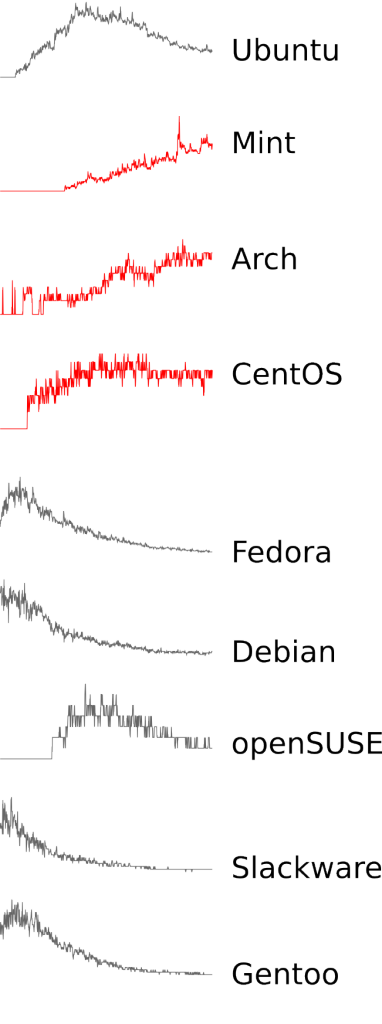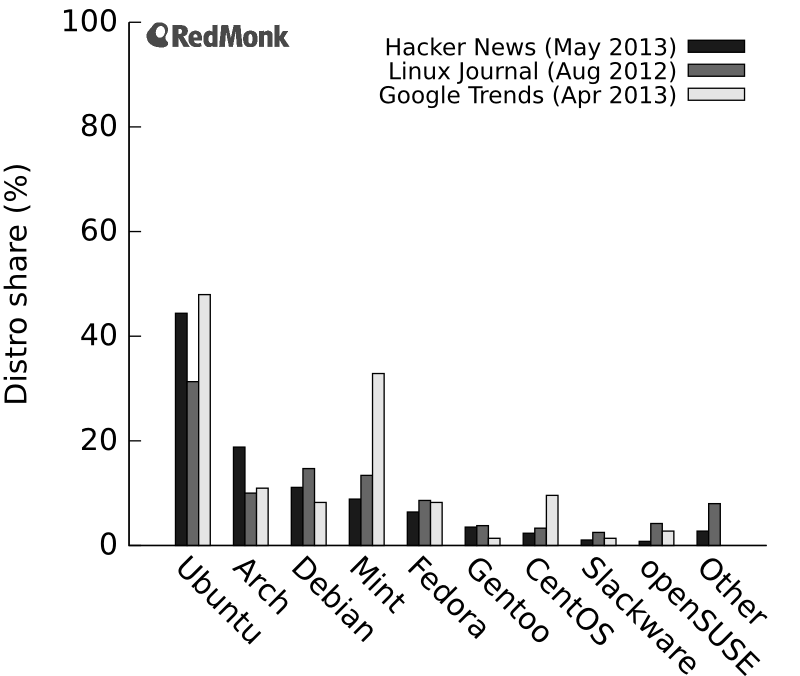A recent poll on Hacker News asking about Linux distributions of choice got me thinking, what can can we learn from a bigger picture of the distro landscape than a single HN poll? I went looking around and dug up a couple of other sources of information — Linux Journal’s annual reader’s choice awards, and data from Google Trends.
What makes these three particular choices interesting is that they span a broad swathe of user types, from the hacker (Hacker News) to the enthusiast (Linux Journal) to the “average” Linux user (Google). That means we can learn from the trends across these three user types — considering which communities may be more predictive or more technical vs which represent broader adoption today.
The results are shown below, ranked by Hacker News popularity so we can see distros popular with highly technical audiences most easily.

We can see that broadly, the trends are consistent across audiences. Smaller differences exist, as well as a couple of clear outliers that are much more popular with a general audience (Linux Mint and CentOS). It’s no surprise to me that Debian- and Ubuntu-based distros are at the top, although the popularity of Arch beyond the enthusiast community surprised me. Let’s dive into the data, one distro at a time:
- Ubuntu: The clear winner among all communities, with nearly half of users in the hacker (HN) and general (Google) communities as well as around 1/3 of enthusiasts (LJ). The relative lack of Ubuntu users among enthusiasts suggests that they may prefer a deeper level of flexibility so they can play around with the distro itself rather than just use it (Google) or build on top of it (HN).
- Arch: A strong showing, led by hackers, with equal proportions in the enthusiast and user communities. This suggests significant general appeal as well as a fulfillment of developer needs, or potentially predictive adoption by the HN community that will later be reflected more widely.
- Debian: Enthusiast-led adoption, with general users trailing.
- Mint: Extremely strong traction among general users, with hackers and enthusiasts far behind although still not negligible.
- Fedora: Broad appeal across many types of users, but trailing well behind the leaders. It’s worth noting that Fedora has perhaps the most even appeal of all distributions — does this mean that being good at everything means being great at nothing?
- Gentoo: No surprise, a source-based distro is most appealing to developers who need the flexibility and enthusiasts who like it.
- CentOS: Very clearly biased toward general users, its RHEL-based nature means it will be quite well-tested while lagging behind in updates. This is a fairly good fit for users who just want their OS to work, but it seems to create problems for enthusiasts and developers, who want or need the latest software.
- Slackware: Enthusiast-led usage.
- openSUSE: A similar trend as Slackware with even weaker developer adoption. It’s much less popular than any of the Debian-based distros or even Fedora, its closest resemblance on the list.
Developers bias toward flexibility and community
To more closely examine which distros the Hacker News community biases towards, above and beyond their larger popularity, I created a graph based on the ratios between HN and Linux Journal or Google Trends usage, respectively. Higher numbers mean a stronger HN bias, while lower ones means a negative HN bias (HN users are less likely to use it).

Compared to enthusiasts (LJ), hackers (HN) lean toward flexibility with Arch and community with Ubuntu, without sacrificing the ease of use required by Gentoo — which is often compared to Arch plus compilation.
Compared to general users (Google), hackers show a very strong leaning toward flexibility with Arch and Gentoo, as well as a weaker bias toward Debian. Interestingly, hackers show a significant bias against CentOS and Linux Mint — we discussed some reasons for CentOS above but the reason for a lack of Linux Mint users is unclear to me.
The decline of the traditional distributions
If we look at trends over time, things really start to get interesting. Here are sparklines indicating changes since 2004 for general users, according to Google Trends, in order of their popularity today:

I’ve shown the distros that are holding stable or growing in red, while the rest are in gray, and a pattern quickly becomes clear: The older Linux distributions appear to be bleeding users. They’re all shrinking after a peak around 2004–2005 (Fedora, Debian, Slackware, Gentoo) or later peaks around 2007–2009 (Ubuntu, openSUSE). The sole exception is CentOS, which is merely holding steady rather than shrinking, perhaps because it has an entirely different set of users than your typical distro.
Where are the users going? Some of them are definitely going to be moving to the growing distros, but many of them are also shifting to another OS entirely — OS X. Next time you’re at a conference, take a look around and count how many Macs and how many PCs you see. Apple’s appeal to developers is undeniable, and some of the more pragmatic Linux users decided that a different Unix-based OS was the better choice for them.
You may have heard, like déjà vu, that this year is the year of the Linux desktop? Looks like it happened back in 2005, and we missed it.
Conclusions
Based on these datasets, the Linux userbase today is defined by Debian-based distros. Ubuntu in particular has made itself interesting to general users and developers alike, a difficult feat. Its popularity in the cloud may well have something to do with its developer appeal. Linux Mint may have hit upon a winning formula for a general userbase, worth looking into for creators of the other distros, while Arch seems to have nailed the hacker community.
Disclosure: Red Hat is a client, and Canonical has been. SUSE and Apple are not.



M-A-O-L » Ranking Linux distributions, and the decline of the traditional distros says:
May 21, 2013 at 2:18 am
[…] Surprised to see Arch so popular. Ranking Linux distributions, and the decline of the traditional distros […]
The Google Cloud Platform Q&A – tecosystems says:
May 23, 2013 at 2:16 pm
[…] begin by standardizing on the preferred distribution of developers. Which would be, according to the research of my colleague Donnie Berkholz, none other than Debian-based distros. You might price competitive […]
dontburnmoney says:
May 23, 2013 at 2:26 pm
Perhaps in 2008-2009 some 50% of Linux-users were using Ubuntu. But not now. More likely the Ubuntu slice is 25-35% and Linux Mint really close on it. Those claims of big Arch Linux adoption are very, very questionable. It’s too hard for average Linux-user to make it working. Even Fedora is easier.
So most likely Ubuntu and Mint has about 50-60% slice and all the others less than 5% each.
Alberto Garcia says:
May 23, 2013 at 3:43 pm
I doubt it. I’m sure around the hacker/enthusiast community it might be close to what you have postulated, but not against ALL Linux-users.
Take Wikimedia’s numbers (http://stats.wikimedia.org/wikimedia/squids/SquidReportOperatingSystems.htm). It’s not even close. By doing some rough math it’s about ~24 million Ubuntu users to to ~0.7 million Mint users.
EDIT:
Don’t forget to look at the Steam numbers. Out of the 2.02% of Linux users, Ubuntu accounts for 1.71% or almost 3/4.
http://www.webupd8.org/2013/03/steam-february-survey-stats-linux.html
Donnie Berkholz says:
May 23, 2013 at 6:04 pm
I’m not sure how to interpret that Wikipedia data since Linux Other is 100x higher than everything but Ubuntu, and Ubuntu is 60x higher than the next distro. I find the former confusing and am somewhat skeptical of the latter disparity. Do you have any idea what Other is supposed to represent?
jgmitzen says:
May 25, 2013 at 1:40 am
The problem is many distros don’t report the specific Linux being used, and many derivatives report their parent distro’s ID, so this isn’t a reliable method.For instance, OpenSUSE just reports Linux x86-64 in my case.
Ernst Lindenberg says:
May 25, 2013 at 8:38 am
Me too. It’s mostly just x86-64. That’s the case even with the newest Open SUSE 12.3 KDE.
jgmitzen says:
May 25, 2013 at 1:41 am
Wikimedia’s numbers are inaccurate because most distros don’t report specific distro names in their browser ID string. Steam is pointless because officially only Ubuntu is supported.
Ernst Lindenberg says:
May 25, 2013 at 8:37 am
I have found that most of sites see my Linux Mint OS as just “Ubuntu”. And that’s not the whole picture. 2 years ago many Android-smartphones were grouped as “Mac” because Safari-browser etc…
FFaael says:
May 25, 2013 at 3:59 pm
And my Arch installation is only linux. This browseridentification only works to identify linux, you can not usually identify distro.
Jorge Castro says:
May 24, 2013 at 5:18 pm
I don’t get how you say that the author’s claims are very questionable and then go on to just make up your own claims.
The author at least laid out his/her methodology.
FFaael says:
May 25, 2013 at 4:08 pm
Most linux user is not regular user. People who can use something like arch is considerably over represented relatively the total population.
Almost all people who is uncomfortable with computers use windows (or sometimes macs). I think it’s likely, if you measure against the total quantity linux user a big part of them is pretty competent.
Ruel Smith says:
May 23, 2013 at 7:25 pm
PCLinuxOS? Mageia?
Links 24/5/2013: Fedora ‘Pidora’, CIvil Rights Debated in the US | Techrights says:
May 24, 2013 at 10:12 am
[…] Ranking Linux distributions, and the decline of the traditional distros […]
Miroslaw says:
May 25, 2013 at 12:29 pm
You do realise that your methodology is pure crap, right?
Roundup: Predictions and Analysis on Software Developers and Development. Nailing it. – James Governor's Monkchips says:
June 20, 2013 at 9:44 am
[…] Ranking Linux Distributions, and the Decline of the Traditional Distros, 2013 […]
Wertilq says:
June 26, 2013 at 3:54 am
Arch is not worth it at all. Tons of work to maintain and install. They push out big changes and force all its users to do the changes manually, without adding scripts to do it.
When an update is needed you can be in a situation were you’re unable to utilize pacman, their package manager, since it forces you to update.
The forum have a requirement of you using a linux-based computer specific command to gain access. If you’re in the middle of the installation you can’t make an account, or like what happened to me, you completely broke my linux and had to use windows for internet, and needed some help, but can’t create an account.
Arch is elistist linux that is not aimed at your average user. Tons of work for little return. I recommend Debian much over Arch. You get pretty much the same thing, with much less work, and much less frustration.
Ubuntu Edge Stops Just Short of the Edge | b log says:
August 28, 2013 at 9:17 am
[…] on some numbers from here, a rough estimate would put Ubuntu/Arch/Debian/Mint at 80% to 90% of the entire Linux distribution […]
What were developers reading on my blog and tweetstream in 2013? – Donnie Berkholz's Story of Data says:
January 6, 2014 at 9:21 am
[…] 21512: Ranking Linux distributions, and the decline of the traditional distro […]
Douglas Dyer says:
June 18, 2014 at 4:04 am
Really interesting approach. And just the approach I was looking for because it identified the “elephant in the room” (Ubuntu). This elephant is not going to disappear any time soon. It’s influence will continue to grow, especially if it continues to make good business decisions. From a business perspective, if you look at how Ubuntu is positioned and in what it is positioned, then you will realize that they really are not going away. Kudos Ubuntu/Canonical … there are many persons who have been waiting for the “elephant in the room”.